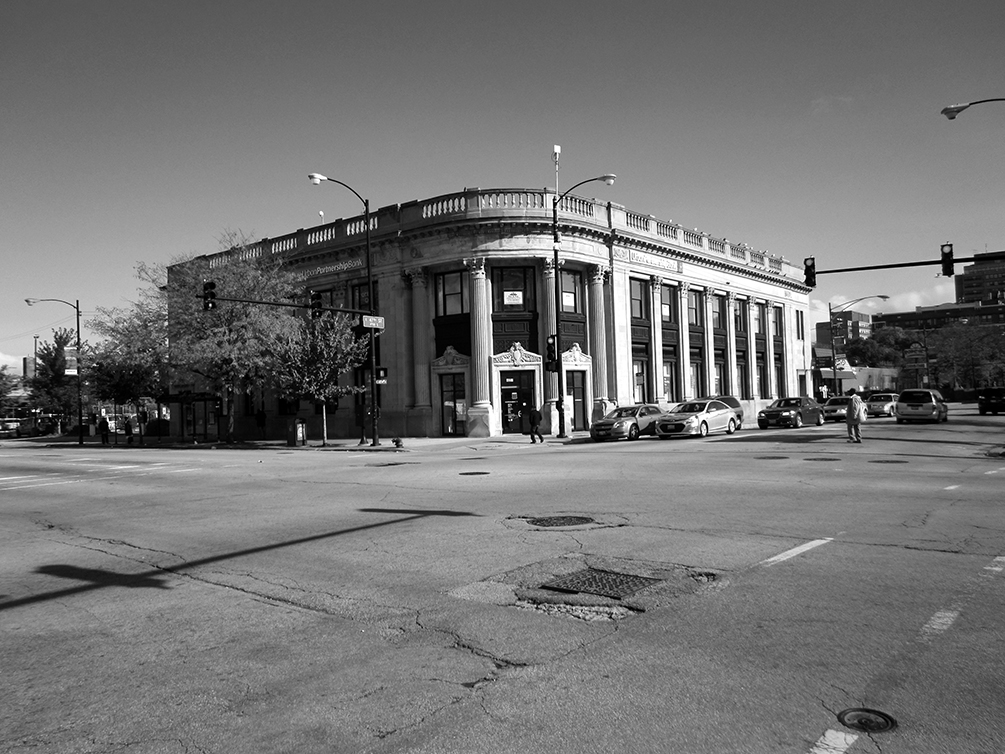
People come and go, buildings rise and fall, and properties change hands, but a bank must always be present to bear witness. In 1922, the South Side Trust and Savings Bank was built on the corner of 47th and Cottage Grove in the classical style. For years people walked between the two-story-tall Indiana limestone pillars that framed the front entrance to conduct their business, helping to make 47th Street the black metropolis it became in the decades following the Great Migration. The building has since become the Urban Partnership Bank, and if current plans succeed, it may witness a rejuvenated Bronzeville of a different form.
Catty-corner to the bank will stand the Shops and Lofts at 47, a five-story, ninety-six-unit mixed-income housing and retail establishment. The cornerstone of this large city investment ($46 million in tax-increment financing assistance) is a 41,000-square-foot Wal-Mart “Neighborhood Market.” Shovels hit the ground in April, in a ceremonial dig, to finally start the project after years of delay; construction is expected to wrap up in 2014.
The project is part of the city’s Cottage Grove Corridor Master Plan, which seeks to develop retail and residential nodes around 43rd, 45th, and 47th Streets. Such a “node-centric” approach to development hopes to consolidate dispersed establishments around major transportation intersections. Other developments in Bronzeville include the Rosenwald Building, which received a $25 million TIF subsidy for restorations, and a return of the Gospel Music Festival in an effort to revitalize the 47th Street blues district.
Despite its central location, 47th and Cottage Grove has until recently only had the bank, a McDonalds, a Save-A-Lot discount grocery store, and an alcohol warehouse and liquor store at the demolished Booker Building. Designed by the prolific architect Horatio Wilson and completed in 1914, this fine brick and terra cotta mixed-use building served as a cornerstone of the commercial district in Bronzeville.
Harold L. Lucas, president of the nonprofit Black Metropolis Convention & Tourism Council, fought to keep the Booker Building standing. According to him, developments could easily have renovated the space and built around it, but the city does not seem to respect Bronzeville’s history or its residents.
“Three out of four blacks,” he says, in a video for the Bronzeville Visitor Information Center on YouTube, “lower-income public-housing residents, have been discriminated against and systematically displaced by the city of Chicago, the State of Illinois, the civic community of the commercial club of Chicago, the University of Chicago, and any number of conspiring politicians and Black elites who would like to change the landscape of Bronzeville and make it an upscale development project.”
Instead of such a gentrification, Lucas would like to see a community-driven development that embraces Bronzeville’s local history, and perhaps even brings tourists interested in the black metropolis that it was earlier in the twentieth century. But with the developments in Bronzeville moving forward as fast as they are, the tension between the old Chicago and the new is not likely to abate very soon.

You nailed it in 300 words, Jon Brozdowski!
Excellent reporting about the re gentrification of Bronzeville.
Consider me as a primary source when reporting about bottom-up human capacity building economic empowerment and entrepreneurial growth in the historic Bronzeville community.
Virtually,
Harold L. Lucas
1-773-819-2055